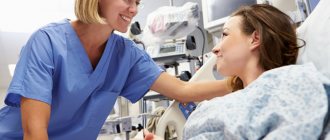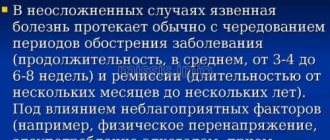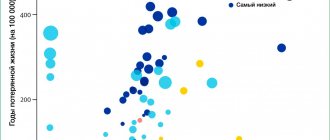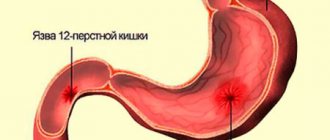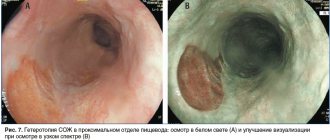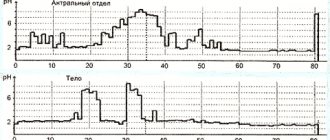There are contraindications. Specialist consultation is required.
With the development of the pharmaceutical industry, this technique is used quite rarely, and preference is given to medicinal methods of treatment. However, if they are ineffective, there is extensive bleeding, or if the ulcer is perforated, surgery is indicated.
Main indications for surgery:
- ineffectiveness of drug treatment, that is, non-healing of the ulcer, two times a year or more - relapses of ulcerations, early relapses after taking medications;
- severe ulcerative pain that limits the ability to work and does not go away despite drug therapy;
- complicated ulcer – bleeding, perforation, narrowing of the pylorus.
Indications for gastrectomy:
- multiple ulcers, of which one is perforated and the other is bleeding;
- extensive callous gastric ulcers;
- simultaneously a stomach and duodenal ulcer.
Preparing for surgery
The patient must undergo endoscopic diagnostics as prescribed by the doctor, as well as standard preoperative preparation, which includes:
- clinical and biochemical blood tests;
- blood tests for HIV, syphilis, hepatitis B and C;
- coagulogram;
- general urine analysis;
- fluorography;
- ECG.
With the results of the examination, you need to visit a therapist, who, in the absence of contraindications, signs permission for the operation. After this, you need to consult with an anesthesiologist and surgeon.
Menu for a week for stomach ulcers
You can stick to this diet after the acute stage of this disease, because the list of allowed foods is longer.
Monday
- Breakfast: semolina porridge cooked in water or milk, cookies, but not rich ones, biscuits are fine, weak tea.
- Snack: low-fat cottage cheese cooked with sugar and berries.
- Lunch: soup cooked in vegetable broth, you can add boiled chicken or lean fish. Baked vegetables, for example, zucchini with carrots, cod cooked in foil in the oven, currant jelly.
- Snack: rosehip decoction, crackers, but not tasty.
- Dinner: mashed potatoes with steamed chicken cutlets, apple compote.
- Late dinner: kefir.
Tuesday
- Breakfast: rolled oats porridge with water or low-fat milk, you can add a little butter. Banana, herbal tea.
- Snack: baked apple in the oven, you can add a little honey.
- Lunch: squash puree soup, boiled buckwheat with minced chicken meatballs stewed in a frying pan, berry jelly.
- Snack: cottage cheese cooked with sugar and banana cut into slices, rosehip decoction.
- Dinner: stewed vegetables, for example, potatoes, zucchini, carrots, onions with cod baked in the oven with sour cream sauce, weak tea.
- Late dinner: yogurt.
Features of the technique
Surgical treatment of this disease is carried out using several methods:
- Vagotomy. This is the intersection of the branches of the nerve that stimulates the production of hydrochloric acid in the stomach. After such an operation, the acidity in the stomach decreases, and the tissues heal on their own.
- Removal of part of the stomach using the Blroth I and II methods, as well as their modifications. During the operation, part of the mucous membrane is removed, which intensively produces enzymes and hydrochloric acid. It can be performed in case of perforation of an ulcer and other complications, provided that the patient’s condition allows it.
- Pyloroplasty. This is a method of treating peptic ulcers of both the stomach and duodenum with narrowing of the duodenal bulb and pylorus.
In some cases, laparoscopic excision of the stomach is performed without large external incisions. This operation is performed in case of complications. If the patient is in serious condition, then the perforated ulcer is simply sutured and the abdominal cavity is drained.
Operations can be carried out planned or urgently. Emergency intervention is indicated for bleeding that is not controlled by medications and perforation of the ulcer. In these cases, the ulcer is sutured, the narrowed digestive tube is expanded, and the bleeding stops.
Surgical treatment is also carried out for malignancy of the ulcer. Its success depends on how early the tumor is detected, whether it has affected only the mucous and submucosal layers or has grown into all layers of the stomach, whether nearby organs and lymph nodes are affected, and whether there are distant metastases.
Antispasmodics and prokinetics - effect on motor skills
With peptic ulcers, gastrointestinal motility disorders are common, both in the direction of inhibition and excessive activation. Painful sensations are very often caused by spasms of the intestines and stomach, which antispasmodics are designed to relieve. These include No-shpa, Papaverine, Halidor, Platyfillin, Metacin, Chlorosil.
The exact opposite effect is caused by prokinetics, which are designed to stimulate contractions of the smooth muscles of the stomach and intestines. Their use may be justified in cases of impaired intestinal motility and inability to empty the stomach. Prokinetics include Motilium, Cerucal, Cesapride, Coordinax, Propulsid.
Possible complications after surgery
Here are statistical data regarding possible complications:
- 16% – seam divergence;
- 11% of cases – intestinal obstruction;
- 8% – violation of evacuation;
- 6% – peritonitis;
- 5% – difficulty swallowing;
- 4% – bleeding into the lumen of the stomach or into the abdominal cavity;
- 3% – infiltrates;
- 3% – suppuration and abscesses.
It is difficult to prevent these consequences, because much depends on the professionalism of the surgeon and the general condition of the patient’s body. The most dangerous complications are internal bleeding and peritonitis, because even death is likely. If the sutures come apart, suppuration or infiltrates appear, the operation is repeated. Difficulty swallowing and impaired evacuation can be treated with certain medications.
Survival prognosis
The life expectancy of patients with an infiltrative form of the tumor depends on at what stage of development the disease was diagnosed and treatment was started.
According to medical statistics, the relationship between the degree of cancer and the percentage of patients who have overcome the five-year survival threshold for adenocarcinoma is as follows:
- I – 72-95%;
- II – 47-87%;
- III – 28-60%;
- IV – 3-20%.
Extensive areas affected by infiltrative cancer, the formation of secondary malignant tumors, and frequent relapses reduce the five-year survival prognosis to 10% of cases.
The result of therapy depends on the correctness of the diagnosis, the quality of medical care, and the patient’s compliance with prescriptions and recommendations. Less than 15% of patients live longer than three years from the date of diagnosis without treatment for cancer.
Rehabilitation after surgery
Rehabilitation should include three main aspects:
- early patient activation;
- therapeutic and breathing exercises;
- special diet.
All this prevents complications and accelerates tissue restoration processes.
On the first day after surgery, passive and active movements of the legs are allowed. From the very first day you need to do breathing exercises. If there are no contraindications, you can get out of bed already on the 2-3rd day.
If recovery goes well, the stitches will be removed on the 8th day. Usually after 2 weeks the patient is already discharged from the hospital if there are no complications and rehabilitation is going well.
Diet after surgery for peptic ulcer
In the postoperative period, you need to follow a very strict diet. If the operation was not severe and without complications, then from the second day you can drink water - 0.5 cups per day with teaspoons. From the third day you can drink 0.5 liters, in addition to water, strong tea and broth are added. From the fourth day you can drink 4 glasses a day, which must be divided into 8-12 doses. As food you can eat jelly, raw eggs, yogurt, slimy soups, sour cream.
From the fifth day, depending on the patient’s condition, you can consume liquid food in unlimited quantities. Grinded soups, cottage cheese, semolina porridge are allowed. From the seventh day you can include well-ground boiled meat in your diet. From approximately the 9th day, the patient switches to diet No. 1a, that is, the anti-ulcer table, with the exception of dishes that are prepared with whole milk. Meals should be fractional - 7 times a day in very small portions.
Treatment options
The main treatment method for infiltrative cancer is surgery. For common forms of neoplasm, it is supplemented with chemotherapy. If surgery is not indicated, only chemotherapy is performed.
Surgery
When treating infiltrative forms of gastric cancer, the following types of operations are used:
- Gastrectomy.
- Subtotal gastrectomy.
In this case, the affected part of the stomach or the entire stomach is removed en bloc with the surrounding tissues, which includes the greater and lesser omentum, fatty tissue and regional lymph nodes of the 1st-2nd order. The intersection of the organ in case of infiltrative cancer is carried out no less than 7 cm from the defined edge of the tumor. To confirm the radicality of the operation, the removed fragment is immediately examined for the presence of tumor cells at the cutting edges.
If cancer spreads to neighboring organs, the scope of the operation may increase and include resection of the affected tissue.
Chemotherapy
Chemotherapy can be used as part of a combination treatment, in conjunction with surgery, or as a stand-alone treatment for unresectable tumors.
The following types of chemotherapy are used as part of combination treatment:
- Perioperative. This type of treatment involves 3 cycles of chemotherapy for 8-9 weeks before surgery, then diagnostic tests are performed, and if there are no signs of unresectable surgery and 3 cycles of chemotherapy after it. The regimens used are CF - cisplatin fluorouracil, and ECF - epirubicin, cisplatin, fluorouracil. This treatment can increase 5-year disease-free survival and generally prolong the life of patients with advanced gastric cancer.
- Adjuvant chemotherapy. This treatment is prescribed 4-6 weeks after surgery if no complications have arisen. Oral forms of fluoropyrimidine are used for 12 months or the XELOX (CAPOX) regimen for 6 months. If the tumor is HER-2 positive, treatment may be supplemented with trastuzumab.
For unresectable forms of stomach cancer, chemotherapy is the main treatment method. As the first line of therapy, regimens including platinum drugs and fluoropyrimidines are prescribed. Three-drug regimens that are supplemented with docetaxel improve overall survival but are more toxic. Therefore, they are prescribed only to healthy patients. If there are bone metastases, bisphosphonates (zoledronic acid) may be prescribed.
The first line of chemotherapy is carried out for 18 weeks, after which the patient is observed until the disease progresses. If it occurs within 3 months after the end of first-line chemotherapy, second-line drugs (taxanes) are used; if more than 6 months have passed after progression, first-line drugs can be used again. With a positive HER2 status, treatment is supplemented with targeted drugs.
In weakened elderly patients with concomitant diseases, gentle treatment is prescribed, and when their condition improves, they switch to the XELOX regimen. Symptomatic treatment is indicated for severely ill patients.
Radiation therapy
Radiation therapy is not used as an independent treatment method. For some time in the United States, adjuvant chemoradiation therapy was the standard of care for locally advanced forms of infiltrative cancer. But prospective studies have shown that this tactic does not improve the prognosis of patients, and the treatment is more toxic compared to adjuvant chemotherapy. Therefore, this approach is not currently recommended.
The main use of radiation therapy is palliative treatment to relieve symptoms of the disease. For example, it is used in the presence of bone metastases to reduce pain.
Symptomatic treatment
The following categories of patients are subject to symptomatic treatment:
- At stage 4 of the disease.
- Patients with locally advanced unresectable forms of cancer.
- Patients with severe concomitant pathology that makes it impossible to perform surgery or use cytostatics.
Symptomatic therapy is aimed at alleviating the patient’s condition and combating complications:
- Elimination of bleeding - often stomach tumors are complicated by heavy bleeding. Patients, in this case, experience vomiting of bloody or scarlet blood, melena in the stool. Endoscopic operations are performed to stop bleeding.
- Combating tumor stenosis - various technologies are used here, from stenting to bypass anastomoses and gastrostomy removal below the site of the lesion.
- Treatment of pain - drug therapy, regional anesthesia, radiation therapy.
- Treatment of ascites is intra-abdominal chemotherapy, laparocentesis, and installation of drainage.
Contraindications for surgery
Absolute contraindications:
- hemorrhagic shock;
- heart diseases with severe circulatory failure;
- purulent peritonitis;
- numerous operations on the abdominal organs;
- lung diseases with respiratory failure;
- blood clotting disorder.
Relative contraindications:
- local diffuse peritonitis;
- diaphragm hernia;
- severe obesity;
- advanced gastrointestinal cancer;
- contraindications to general anesthesia.
Types of infiltrative type of oncopathology
According to the Borrmann classification, doctors divide the disease into two types:
- The diffuse infiltrative form of adenocarcinoma is difficult to diagnose. Its distinctive characteristics are: complete loss of elasticity of the organ wall in the affected area, smoothed surface, pale mucous membrane. This type of oncopathology accounts for 15-35% of the total number of identified cases;
- the ulcerative-infiltrative type is diagnosed in 45-60% of oncological findings. The tumor looks like an ulcer with a bumpy bottom, blurry borders on a thickened mucous membrane. The folds of the neoplasm are wide, small in height, retain their shape under air pressure, and the color is almost the same as the surrounding tissue.
Any form of the disease can masquerade as an ulcer.
The visual similarity during endoscopic examination of malignant neoplasms with benign ulcers and gastritis makes diagnosis difficult.
Prevention of recurrence of the disease
First of all, you need to exclude factors that cause peptic ulcer:
- alcohol consumption;
- stress;
- smoking;
- heavy physical activity;
- improper diet, eating fried, spicy foods, smoked foods, fast food;
- non-compliance with diet.
To prevent ulcers you need:
- sleep at least 6-8 hours a day;
- minimize the consumption of foods that irritate the gastric mucosa - fatty, smoked, fried;
- chew food well;
- eat up to 6 times a day;
- eat chopped food, cereals, jelly, omelettes, vegetables, steamed meat;
- See a doctor immediately if you have stomach pain;
- eliminate alcohol and smoking;
- protect yourself from stress;
- reduce coffee consumption to a minimum;
- eat boiled, baked, steamed food with a minimum of spices.
You need to visit a doctor for preventive examinations once a year. Also, for prevention, all patients are prescribed courses of antiulcer medications in the summer and spring.
What can you eat while on a diet for stomach ulcers?
The foods that people with these diseases can eat are quite varied. You can eat almost all vegetables, except those that cause gas. It is better to cook them in the oven or stew. You can come up with many different dishes with potatoes, for example, make mashed potatoes, cook soup, make a casserole. Lean meat and dietary fish are good to steam, stew or bake. You can diversify your menu with steamed cutlets made from lean minced meat.
Suitable drinks include compotes, jelly, rosehip infusions, weak tea, and plain water.
It is necessary to carefully monitor the temperature of drinks; you should not drink too cold or too hot.
To pamper yourself with desserts, you can come up with a variety of cottage cheese casseroles and add fruit to them. Sometimes you can allow yourself a little candy or marshmallow, or a couple of slices of good chocolate. But not during the period of exacerbation. You need to be careful when consuming baked goods; under no circumstances should you eat fresh baked goods, nor should you eat puff pastries. It is better to choose unsweetened crackers or dry cookies.

